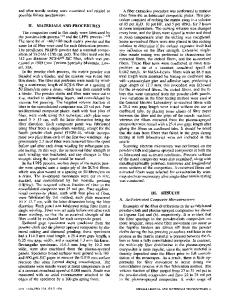A Comparison of Mechanical and Electrical Properties in Hierarchical Composites Prepared using Electrophoretic or Chemic
- PDF / 610,433 Bytes
- 7 Pages / 432 x 648 pts Page_size
- 6 Downloads / 301 Views
Advances:
Email alerts: Click here Subscriptions: Click here Commercial reprints: Click here Terms of use : Click here
A Comparison of Mechanical and Electrical Properties in Hierarchical Composites Prepared using Electrophoretic or Chemical Vapor Deposition of Carbon Nanotubes Andrew N. Rider, Qi An, Narelle Brack and Erik T. Thostenson MRS Advances / Volume 1 / Issue 12 / January 2016, pp 785 - 790 DOI: 10.1557/adv.2015.51, Published online: 06 January 2016
Link to this article: http://journals.cambridge.org/abstract_S2059852115000511 How to cite this article: Andrew N. Rider, Qi An, Narelle Brack and Erik T. Thostenson (2016). A Comparison of Mechanical and Electrical Properties in Hierarchical Composites Prepared using Electrophoretic or Chemical Vapor Deposition of Carbon Nanotubes. MRS Advances, 1, pp 785-790 doi:10.1557/adv.2015.51 Request Permissions : Click here
Downloaded from http://journals.cambridge.org/ADV, IP address: 131.111.164.128 on 13 Aug 2016
MRS Advances © 2016 Materials Research Society DOI: 10.1557/adv.2015.51
A Comparison of Mechanical and Electrical Properties in Hierarchical Composites Prepared using Electrophoretic or Chemical Vapor Deposition of Carbon Nanotubes Andrew N. Rider1, Qi An2, Narelle Brack3 and Erik T. Thostenson2 1 Defence Science and Technology Group, Fisherman’s Bend, Victoria 3207, Australia 2 Department of Mechanical Engineering, Department of Materials Science and Engineering, and Center for Composite Materials, University of Delaware, Newark, DE 19716, USA 3 Department of Chemistry and Physics, La Trobe Institute for Molecular Science, La Trobe University, Melbourne, Victoria, 3086, Australia ABSTRACT Two approaches have been employed in the preparation of hierarchical composite laminates with a carbon nanotube (CNT) phase. Glass fibers were coated with CNTs using electrophoretic deposition (EPD) prior to infusion with epoxy resin. The CNTs were functionalized using an ultrasonicated-ozone process followed by reaction with polyethyleneimine (PEI) to enhance CNT to fiber and matrix adhesion. Chemical vapor deposition (CVD) was also used to grow CNTs onto quartz fibers, prior to infusion with an epoxy resin modified with a thermoplastic nanophase. The mechanical performance of the two CNT laminates types were similar, however, the fracture surfaces indicated distinct differences. The EPD laminates showed fracture in the CNT-rich interphase region, whereas, the CVD laminates showed that strength was limited by adhesion failure at the CNT-fiber interface. The electrical conductivity of CVD laminates was 100 times higher than EPD laminates. For the EPD laminates the PEI functionalization increases the CNT-CNT distance resulting in reduced conductivity, while the high CNT packing density and residual iron catalyst on the fiber surface in the CVD laminates creates conducting pathways resulting in higher conductivities. INTRODUCTION The development of hierarchical composite structures offers the potential to increase the functionality and performance of traditional fib
Data Loading...











